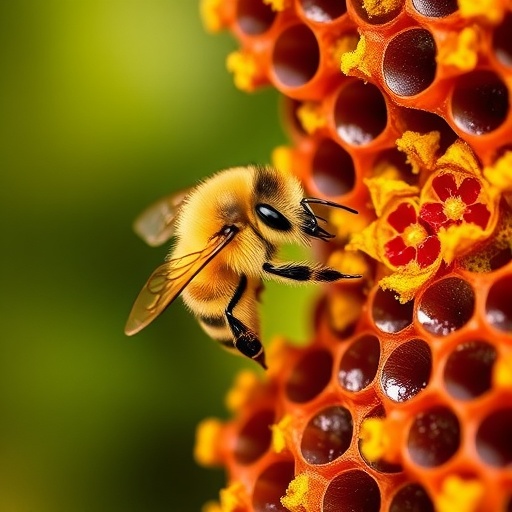Honeybee hives represent some of nature’s most intricate and vital ecosystems, full of pollen, wax, and honey—resources that are fiercely protected yet irresistibly rich targets for a wide array of parasitic threats. The ongoing battle between honeybees and their parasites—which range from protists and viruses to fungi and arthropods—poses significant challenges for apiarists worldwide. With over 30 known parasites currently afflicting honeybees, researchers remain on a relentless quest to find novel, ecofriendly means to safeguard these essential pollinators from devastating diseases.
Recently, a pioneering team of researchers based in the United States identified an untapped reservoir of potential in the very pollen honeybees gather during their daily foraging. They hypothesized that endophytes—symbiotic bacteria and fungi residing within plant tissues—play a protective role not only within the plants themselves but also confer benefits to their pollinators. This intriguing hypothesis stemmed from the evolutionary logic that by enhancing pollinator health, these microbial partners effectively ensure the continued reproduction and dispersal of their host plants.
In groundbreaking findings published in Frontiers in Microbiology, the team demonstrated that these beneficial bacteria are indeed present both on the pollen collected from plants and in the pollen stores within honeybee hives. More importantly, these microbes produce antimicrobial compounds that inhibit key pathogens affecting both bees and crops, pointing to a promising avenue for developing sustainable disease management strategies that leverage nature’s own defenses.
The focus of their inquiry was the phylum Actinobacteria, a prolific group celebrated for its vast repository of medically and agriculturally valuable natural products. Actinobacteria are known to be the cornerstone of many antibiotics used in human and veterinary medicine. Between April and June of 2021, the researchers meticulously gathered samples from ten species of native plants within the Lakeshore Nature Preserve at the University of Wisconsin – Madison, as well as from the pollen stores of a proximate honeybee colony.
Isolation and genomic sequencing revealed the presence of 16 distinct strains of actinobacteria from plant samples and 18 strains from hive pollen. A striking 72% of these isolates belonged to the genus Streptomyces, acclaimed worldwide as a prolific source of bioactive compounds ranging from antibiotics to anticancer agents. What’s more, several of these Streptomyces strains closely mirror organisms currently being examined for their potential to combat crop diseases, underscoring a dual role in protecting both plant and pollinator health.
To probe their antimicrobial efficacy, the researchers executed competition assays, co-culturing isolated Streptomyces strains alongside known pathogens. Nearly all strains efficiently curtailed the growth of Aspergillus niger, a fungal pathogen responsible for stonebrood disease in honeybees—a major threat that can decimate hives. Selected strains also demonstrated potent activity against bacterial honeybee pathogens such as Paenibacillus larvae and Serratia marcescens, as well as against plant pathogens including Erwinia amylovora, Pseudomonas syringae, and Ralstonia solanacearum, notorious for causing blights and wilts in economically important crops.
“These Streptomyces bacteria are not random passengers on pollen grains; they are endophytic symbionts, intimately associated with the plant host,” explains Dr. Daniel May, the study’s corresponding author from Washington College. The team’s genomic analyses uncovered gene clusters that enable these bacteria to invade plant tissues, synthesize growth-promoting hormones, and scavenge essential metals within the rhizosphere, all hallmark traits of bona fide endophytes.
The results illuminate a fascinating ecological journey: as bees visit flowers, they inadvertently collect and transport these beneficial actinobacteria back to their colonies, where the microbes colonize hive pollen stores and help mount a natural defense against debilitating pathogens. This dynamic interkingdom relationship highlights the sophisticated coevolutionary arms race between plants, microbes, and their insect visitors.
Beyond its immediate ecological significance, this study underscores the broader paradigm that preserving diverse floral landscapes is paramount for the health of managed and wild pollinators alike. A rich tapestry of plant species promotes a more diverse microbiome of endophytes available to pollinators, fortifying them against threats and supporting resilient ecosystems.
Looking ahead, these insights herald an exciting future where targeted inoculation of hives with beneficial Streptomyces strains could transform apiculture. Such biocontrol interventions might reduce dependence on antibiotics and pesticides, mitigating risks of resistance and environmental contamination while bolstering colony health. Integrating these natural microbial allies into hive management strategies could revolutionize how we protect the cornerstone pollinators of global food webs.
Moreover, the implications extend into agriculture: the same compounds that suppress bee pathogens show promise as biopesticides against crop pathogens, offering a sustainable alternative to chemical controls. This cross-domain utility exemplifies the power of exploring microbial symbioses unveiled in natural systems.
As Dr. May articulates, “The future of treating bee diseases might be as straightforward as introducing specific beneficial bacteria into the hives. This naturally evolved microbial arsenal could simultaneously safeguard crops and enhance pollinator resilience.” Such a vision aligns with the growing movement to harness microbiomes for sustainable development goals in agriculture and conservation.
The study not only broadens our fundamental understanding of the microbial underpinnings of pollination biology but also exemplifies how cutting-edge molecular tools like genome sequencing and interspecies competition assays can unlock novel solutions to pressing ecological challenges. It is a vivid testament to the hidden treasures housed within microscopic symbionts and their enormous potential for addressing global environmental and food security crises.
In conclusion, this research documents a symbiotic nexus where plants, microbes, and pollinators coalesce into a finely tuned protective network. By leveraging the antimicrobial prowess of endophytic Streptomyces bacteria harbored in pollen, scientists are poised to pioneer innovative and sustainable strategies for combating devastating diseases in both apiculture and agriculture. This elegant discovery propels us closer to a future where nature-inspired solutions become the cornerstone of ecosystem health and human well-being.
Subject of Research: Animals
Article Title: Endophytic Streptomyces from Honeybee Hives Inhibit Plant and Honeybee Pathogens
News Publication Date: 30-Sep-2025
Web References: https://www.frontiersin.org/journals/microbiology/articles/10.3389/fmicb.2025.1644842/full
References: DOI: 10.3389/fmicb.2025.1644842
Keywords: Honeybee diseases, Endophytic actinobacteria, Streptomyces, Antimicrobial compounds, Pollinator health, Ecofriendly biocontrol, Pollen microbiome, Crop pathogens, Microbial symbiosis, Sustainable agriculture




